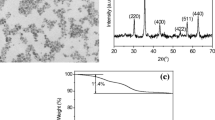Abstract
Using emulsion copolymer of styrene (St), glycidyl methacrylate (GMA) and 2-hydroxyethyl methacrylate (HEMA) as seed latexes, the superparamagnetic polymer emulsion particles were prepared by seeded emulsion copolymerization of butyl methacrylate (BMA), vinyl acetate (VAc) and ethylene glycol dimethacrylate in the presence of the seed latexes and superparamagnetic Fe3O4/SiOx nanoparticles (or Fe3O4-APTS nanoparticles) through a two-step process, without addition of any emulsifier. The magnetic emulsion particles named P(St-GMA-HEMA)/P(BMA-VAc) were characterized by transmission electron microscope and vibrating sample magnetometry. The results showed that the magnetic emulsion particles held a structure with a thinner shell (around 100 nm) and a bigger cavity (around 200 nm), and possessed a certain level of magnetic response. The resulting magnetic emulsion particles were employed in the immobilization of lipase by two strategies to immobilized lipase onto the resulting magnetic composites directly (S-1) or using glutaraldehyde as a coupling agent (S-2), thus, experimental data showed that the thermal stability and reusability of immobilized lipase based on S-2 were higher than that of S-1.










Similar content being viewed by others
References
Du, Y. Z., Tomohiro, T., & Kodaka, M. (2004). Macromolecules, 37, 803–812.
Okubo, M., & Ahmad, H. (1999). Colloids Surfaces A, 153, 429–433.
Ugelstad, J., Stenstad, P., Kilaas, L., Prestvik, W. S., Herje, R., Berge, A., et al. (1993). Blood Purification, 11, 349–369.
McCloskey, K. E., Chalmers, J. J., & Zborowski, M. (2003). Analytical Chemistry, 75, 6868–6874.
Horak, D., Babi, M., Mackova, H., & Bene, M. J. (2007). Journal of Separation Science, 30, 1751–1772.
Li, X., & Sun, Z. (1995). Journal of Applied Polymer Science, 58, 1991–1997.
Horak, D., Bohaek, J., & Ubrt, M. (2000). Journal of Applied Polymer Science, 38, 1161–1171.
Cocker, T. M., Fee, C. J., & Evans, R. A. (1997). Biotechnology and Bioengineering, 53, 79–87.
Lee, Y., Rho, J., & Jung, B. (2003). Journal of Applied Polymer Science, 89, 2058–2067.
Yanase, N., Noguchi, H., Asakura, H., & Suzuta, T. (1993). Journal of Applied Polymer Science, 50, 765–776.
Kondo, A., Kamura, H., & Higashitani, K. (1994). Applied Microbiology and Biotechnology, 41, 99–105.
Lu, S., Qu, R., & Forcada, J. (2009). Materials Letters, 63, 770–772.
WANG, Q., Fu, S., & YU, T. (1994). Progress in Polymer Science, 19, 703–753.
Tang, C., Zhang, C., Liu, J., Qu, X., Li, J., & Yang, Z. (2010). Macromolecules, 43, 5114–5120.
Schmidt, R. D., & Verger, R. (1998). Angewandte Chemie International Edition, 37, 1608–1633.
Jaeger, K. E., Dijkstra, B. W., & Reetz, M. T. (1999). Annual Review of Microbiology, 53, 315–351.
Villeneuve, P., Muderhwa, J. M., Graille, J., & Haas, M. J. (2000). Journal of Molecular Catalysis B: Enzymatic, 9, 113–148.
Maria, D. V., Isabel, A., Sol, M. O., Alicia, B., Rodolfo, S., Jose, M. L., et al. (1995). Applied Biochemistry and Biotechnology, 50, 127–136.
Ernandes, B. P., Heizir, F. D. C. A., Flavio, F. D. E. M., & Gisella, M. Z. (2001). Applied Biochemistry and Biotechnology, 91–93, 739–752.
Mahiran, B., Sunana, S., Mansor, B., Chenyonya, A. R., & Abu, B. S. (1999). Applied Biochemistry and Biotechnology, 81, 205–217.
Clark, D. S. (1994). Trends in Biotechnology, 12, 439–443.
Massart, R., & Cabuil, V. J. (1987). Journal de Chimie Physique et de Physico-Chimie Biologique, 84, 967–973.
Cui, Y. J., Li, Y. F., et al. (2010). Journal of Biotechnology, 150, 171–174.
Kobayashi, H., & Matsunaga, T. (1991). Journal of Colloid and Interface Science, 141, 505–511.
Watanabe, N., Yasude, O., Yasuji, M., & Koichi, Y. (1977). Agricultural and Biological Chemistry, 41, 1353–1358.
Bradford, M. M. (1976). Analytical Biochemistry, 72, 248–254.
Santra, S., Tapec, R., Theodoropoulou, N., Dobson, J., Hebard, A., & Tan, W. H. (2001). Langmuir, 17, 2900–2906.
Xi, F. N., Wu, J. M., Jia, Z. S., & Lin, X. F. (2005). Process Biochemistry, 40, 2833–2840.
Acknowledgments
The authors thank the financial supports from the National Natural Science Foundation of China (No.21374045, No.21074049), the National Natural Science Foundation for the scientific research ability training of undergraduate students majoring in chemistry by the two patterns based on the tutorial system and top students (J1103307) and the Opening Foundation of State Key Laboratory of Applied Organic Chemistry (SKLAOC-2009-35).
Author information
Authors and Affiliations
Corresponding author
Rights and permissions
About this article
Cite this article
Cui, Y., Chen, X., Li, Y. et al. Superparamagnetic Polymer Emulsion Particles from a Soap-Free Seeded Emulsion Polymerization and their Application for Lipase Immobilization. Appl Biochem Biotechnol 172, 701–712 (2014). https://doi.org/10.1007/s12010-013-0563-x
Received:
Accepted:
Published:
Issue Date:
DOI: https://doi.org/10.1007/s12010-013-0563-x




